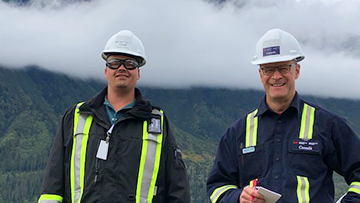Safety and Environment

Services and Information
Access reports and learn more about compliance verification activities, inspections, audits, and enforcement.
Get details on how landowners, contractors, companies, the agricultural sector, and other government agencies can help prevent damage to pipelines.
Report an incident, find out how we expect companies to manage and prepare for an emergency, read about our emergency readiness and response, and learn about the polluter pays principle.
Read more on what we protect and what that looks like over the lifecycle of a project. Find out what is required in an environmenal assessment, and learn more about remediation, watercourse crossings, and post-construction monitoring.
Read advisories, pipeline performance reports or stay informed about recent compliance verification activities and enforcement actions. Research incidents and events using Tableau and interactive tools and maps of pipelines in Canada.
Quality assurance of pipeline fittings
Learn about pipeline fittings, the standards and requirements we expect companies to meet, and how we have been working to improve those standards and requirements.
Report suspicious activity or learn more about regulations for security management programs for pipelines or get information on standards for companies operating international power lines.
Learn about girth weld area strain-induced failures, how to prevent them, and how we have been working with industry to prevent the issue.
Discover how an environment where staff are actively engaged and are well trained to watch for risks is essential to prevent incidents and harm. Learn about cultural threats and defenses, read our statement on safety culture, and find out more about the research and outreach we do to help build and share what we know about safety culture.
Human and Organizational Factors
Learn how understanding and managing human and organizational factors can help prevent major incidents.
Living and working near pipelines
Transcript:
At the Canada Energy Regulator, we hold companies to some of the strictest safety and environmental standards in the world.
These rules help to keep you and the people you love safe.
Pipelines are the main way products like oil and gas are moved across the country.
One of the biggest hazards for pipelines, is people digging without knowing where they are buried.
That is why it is so important that everyone living or working near pipelines understands the risks and take precautions.
We have guidelines that tell companies and individuals how to safely live and work near pipelines.
These are called the CER Damage Prevention Framework.
We also have experts in damage prevention and who do things like:
- Inspect the area around pipelines to make sure it is clearly marked and to check for potentially dangerous activities
- Make sure companies have detailed plans and programs to prevent damage to the pipelines they operate
- Teach people about how to stay safe around pipelines and what their responsibilities are
- And do in-depth Inspections and audits on pipeline companies to make sure they are following the rules.
If we see that a company isn’t doing something right, we make sure they fix the problem.
Companies must report to us if they see any activities that could potentially damage a pipeline.
Before anyone does work that involves digging, they must contact the “one call centre” to place a locate request.
The easiest way to do that is to go to Click Before You Dig to connect to the one call centre in the province or territory where they live.
It’s the law.
The One Call Centre will let the companies that have buried lines in the area know that you are planning to dig.
Those companies will tell you if there are pipelines buried under the ground that you need to avoid or other things like communications or electrical lines.
Preventing damage to pipelines is everyone’s responsibility and it helps to keep everyone living and working near pipelines safe.
Want to learn more about preventing damage to pipelines and how the CER works for you?
Visit us online or contact us directly.
One of the biggest hazards with living and working around pipelines is digging without knowing where they are buried. We help make sure everyone understands the risks and takes precautions.
Features
Pipeline Incident Data
Data visualization
Pipeline companies we regulate
- Date modified:



